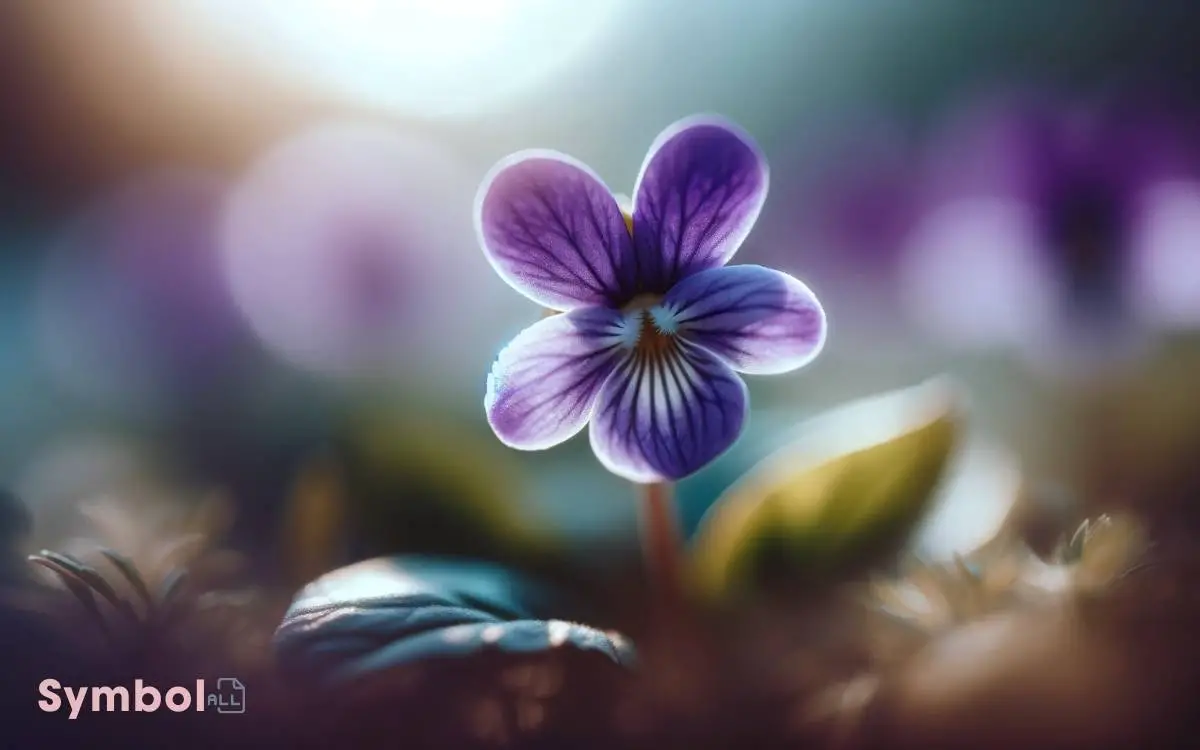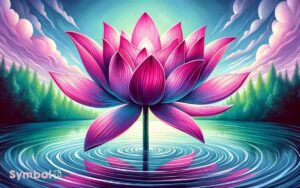What Does the Violet Flower Symbolize? Wealth, Spirituality!
You’ll find that violet flowers are rich in symbolism, conveying wealth, spirituality, and wisdom. Historically tied to elite status, their color comes from anthocyanins, signaling antioxidant qualities with profound health impacts.
In romance, they express deep love and enduring devotion, with their scent amplifying these sentiments. Violets also signify a bridge between the material and spiritual, hinting at spiritual enlightenment.
They embody change, aiding in mourning by representing peace amid sorrow. Moreover, their modest appearance underscores humility.
Each hue and aroma hints at a deeper connection to both the earthly and divine, offering a pathway to understanding a broad spectrum of human emotions and spiritual quests. Uncovering their layers reveals more about our complex interactions with the natural world.

Key Takeaways
Historical Significance
Throughout history, violet flowers have symbolized wealth, spirituality, and wisdom, deeply influencing various cultures with their rich hues and multifaceted meanings.
You’ll find that the violet’s significance is rooted in its unique pigment, which was once rare and costly to produce. This scarcity led to its association with elite status and power.
Scientifically, the violet’s color results from anthocyanins, compounds with antioxidant properties, suggesting a correlation between the flower and health, further elevating its esteemed symbolism.
Culturally, violets were embedded in ancient Greek rituals, symbolizing the connection between the earthly and the divine, a demonstration of their spiritual significance.
Analyzing these elements reveals how the historical importance of violets extends beyond their aesthetic appeal, embodying complex societal values and beliefs.
Love and Affection
In your exploration of violet flowers, you’ll find that they’re deeply emblematic of romantic expressions and enduring devotion.
These blooms serve as a sophisticated symbol in the language of flowers, often conveying feelings of love with a depth that surpasses verbal communication.
Scientific analysis reveals that their unique hues and structures are biologically designed to attract attention, making them an ideal candidate for manifesting affection.
Romantic Expressions
Violet flowers symbolize deep love and affection, offering a profound way to express romantic sentiments without words. In the domain of floral symbolism, violets stand out due to their unique biochemistry.
Their color, derived from anthocyanin pigments, not only captivates the eye but also serves as a visual metaphor for the depth and complexity of human emotions.
Scientifically, the scent of violets, caused by ionone compounds, plays a significant role in their association with romantic expressions.
This aroma has the distinctive ability to momentarily desensitize the olfactory system, creating a delicate, fleeting experience akin to the ephemeral nature of love.
Presenting violets in a romantic context isn’t merely traditional; it’s a nuanced form of communication, leveraging the flower’s inherent properties to convey intricate feelings of love and affection.
Enduring Devotion
Violets, with their deep hues and delicate aroma, serve as a powerful symbol of enduring devotion, reflecting not only the intensity but also the permanence of love and affection between individuals.
This symbolism isn’t arbitrary but deeply rooted in the flower’s biological and historical significance.
- Biological resilience: Violets thrive in various climates, symbolizing the ability of true love to withstand challenges.
- Historical significance: Cultures worldwide have used violets to represent eternal loyalty, embedding these meanings into our collective consciousness.
- Chemical composition: The scent of violets, primarily due to ionone, directly impacts the human brain, invoking deep emotional responses.
Understanding these aspects provides a robust framework for why violets are more than just aesthetically pleasing they’re a profound emblem of unwavering love and commitment.
Spiritual Enlightenment
You’ll find that the symbolism of violet flowers bridges the gap between the material and the spiritual, offering a unique pathway to spiritual enlightenment.
From a scientific standpoint, the color violet possesses the shortest wavelength on the visible light spectrum, symbolizing a shift from the tangible to the intangible spheres.
This characteristic aligns with the pursuit of spiritual enlightenment, which often involves transcending physical realities to connect with a higher consciousness.
Analyzing the violet’s growth habits provides further insight; these flowers thrive in both sunlight and shade, symbolizing the ability to find enlightenment in varied life circumstances.
Their resilience and adaptability suggest that spiritual growth is accessible to you, regardless of your current position on your journey.
Transition and Mourning
Exploring the symbolism of violet flowers further, it’s evident that these blooms also profoundly embody feelings of mourning and the process of grieving, serving as a bridge between loss and the possibility of eventual peace.
The violet’s delicate appearance belies its rich symbolic dimensions, which are deeply interwoven with human experiences of change and mourning.
- Color significance: The deep purple hue of violets is traditionally associated with sorrow and remembrance, reflecting a period of introspection and homage to the departed.
- Seasonal blooming: Violets often bloom in early spring, symbolizing the cyclical nature of life and death, and offering a metaphor for rebirth following loss.
- Historical usage: Cultures have used violets in funeral rites and memorials, leveraging their imagery to express the unspeakable grief and the hope for peace beyond pain.
Humility and Modesty
You’ll find that the historical roots of violet flowers symbolizing humility and modesty are deeply embedded in various cultures’ folklore and traditions.
This association stems from the flower’s unassuming appearance and its tendency to thrive in hidden, shaded areas, which has led to its cultural interpretations as a symbol of modesty.
Detailed analysis reveals that these interpretations aren’t arbitrary but are grounded in the flower’s botanical characteristics and ecological behaviors.
Historical Roots
Throughout history, violet flowers have symbolized humility and modesty, reflecting societal values and cultural beliefs. Their understated elegance often made them a preferred emblem for those wishing to convey depth without ostentation.
Analyzing the historical roots of this symbolism reveals a consistent thread:
- Ancient texts and artifacts suggest violets were favored for their subtle beauty and fragrance, embodying quiet dignity.
- Medieval literature frequently associates violets with humility, using them as metaphors in religious and philosophical texts.
- Botanical studies have shown that violets thrive in humble conditions, often flourishing in the wild under the canopy of larger plants, which parallels their symbolic association with modesty.
Understanding these historical roots enriches your appreciation of the violet’s enduring symbol of humility and modesty in various cultures.
Cultural Interpretations
Delving into cultural interpretations, it’s evident that violets’ symbolism of humility and modesty resonates across various societies, each adding its own nuanced understanding to this floral emblem.
Analyzing this symbolism through a scientific lens, you’ll find that the plant’s modest growth habits and the way it thrives in shaded, unassuming locations contribute to its association with these virtues.
Additionally, the violet’s small yet vibrant blooms serve as a metaphor for the quiet strength and dignity found in humility.
| Culture | Interpretation |
|---|---|
| Ancient Greece | A symbol of modesty, used in rituals to honor Artemis. |
| Victorian England | Communicated humility in the complex language of flowers. |
| Japanese Hanakotoba | Represents honesty, a subdued form of beauty. |
This table encapsulates the diverse cultural lenses through which the violet’s symbolism is viewed, highlighting its global relevance.
Healing and Protection
Historically, violet flowers have been associated with healing and protection due to their unique chemical properties and symbolic meanings. These delicate blooms aren’t just an exploration for the eyes; they’re a powerhouse of medicinal and protective attributes.
When you investigate the scientific intricacies of violets, you uncover a fascinating domain of therapeutic potential.
- Antioxidant Properties: Violets contain high levels of antioxidants, which combat free radicals and support your body’s natural defense mechanisms.
- Anti-Inflammatory Effects: The compounds within violet flowers have been shown to reduce inflammation, offering relief from conditions like arthritis and other inflammatory diseases.
- Natural Antiseptic: Violets possess natural antiseptic qualities, making them useful in preventing infections and protecting wounds.
Understanding these aspects underscores the deep-rooted connection between violets and their role in healing and protection.
Renaissance of Violets
Building on their medicinal and protective qualities, violets experienced a substantial resurgence during the Renaissance, reflecting a broader cultural and scientific appreciation of their benefits.
This era, known for its revitalization of arts and sciences, also marked a pivotal moment for botany.
Scholars and herbalists delved into the study of plants with a renewed vigor, cataloging their properties with unprecedented detail. In this intellectual climate, violets were celebrated not only for their aesthetic appeal but also for their therapeutic applications.
The Renaissance’s analytical approach to flora, emphasizing empirical observation and documentation, advanced the understanding of violets significantly.
Researchers during this period began to systematically explore the compounds within violets that contributed to their effectiveness in treating a range of ailments, laying the groundwork for future botanical and medical advancements.
Victorian Era Meanings
During the Victorian era, the language of flowers, known as floriography, became a nuanced form of communication, with violets embodying messages of loyalty, devotion, and modesty.
This period saw a proliferation of floral dictionaries, enabling people to express complex emotions and sentiments without uttering a single word.
Violets, in particular, held a special place in this botanical lexicon for several reasons:
- Loyalty: Violets symbolized unwavering fidelity, often exchanged between close friends and lovers to signify their steadfast commitment.
- Devotion: The flower was a testimony to the depth of one’s feelings, representing profound emotional and spiritual dedication.
- Modesty: Their delicate appearance and subtle fragrance were emblematic of humility and restraint, virtues highly esteemed during the Victorian era.
This intricate floral language allowed individuals to convey feelings that societal norms otherwise compelled them to suppress, making violets a powerful emblem of innermost truths.
Dream Interpretations
In the domain of dream interpretation, coming across violets can symbolize a variety of profound emotional states and shifts, reflecting your subconscious’s intricate workings. Seeing violets in dreams often points to a deep longing for tranquility and harmony.
Their presence might suggest a need to connect more profoundly with your inner self or intimate emotions that you’ve been neglecting.
Scientifically, the brain’s way of processing emotions and experiences during REM sleep can manifest symbolically.
Violets, with their delicate appearance and association with peace, might represent an attempt by your psyche to soothe internal turmoil or signal the emergence of suppressed feelings.
Analyzing the context in which violets appear in your dream can provide insights into your emotional well-being or areas that require your attention.
Cultural Variations
Exploring the cultural variations of violet flowers reveals how societies worldwide ascribe unique meanings and values to this bloom, reflecting diverse historical, spiritual, and emotional contexts.
The intricate symbolism associated with violets varies considerably across cultures, offering a rich tapestry of interpretations that underscore the flower’s global resonance.
- Ancient Greece: Violets symbolized fertility and love, woven into myths involving the goddess Aphrodite.
- Medieval Europe: They represented modesty and humility, aligning with Christian values of simplicity and purity.
- Japanese Hanakotoba: Violets convey sincerity and deep emotional connection, reflecting the nuanced language of flowers in Japanese culture.
These examples illustrate how the violet flower transcends mere aesthetic appreciation, embodying complex societal values and emotions.
Understanding these cultural nuances provides deeper insight into the symbolic significance of violets around the world.
Modern Symbolism
In modern contexts, you’ll find that violet flowers carry nuanced meanings, ranging from expressions of love and adoration to indicating spiritual awakening.
These flowers also symbolize healing and protection, reflecting their use in various therapeutic and medicinal applications.
Through a detailed examination of their symbolism, it’s clear that violets have evolved to represent complex human emotions and states of being in contemporary culture.
Love and Adoration
Violet flowers symbolize love and adoration, serving as a complex emblem in modern symbolism that reflects deep affection and admiration. These flowers convey nuanced emotions through their vibrant hues and delicate appearance, embodying sentiments that are profound yet tender.
In the context of love and adoration, violets communicate:
- Enduring love: Their perennial nature symbolizes a love that withstands the test of time, resilient and ever-present.
- Modesty and humility: The violet’s small and unassuming form represents a love that’s genuine, devoid of pretense or ostentation.
- Devotion: The flower’s tendency to thrive in hidden, shaded areas symbolizes a devoted, unwavering affection that doesn’t seek the spotlight but flourishes in the sincerity of heartfelt emotion.
In analyzing violets within this framework, one gains insight into the complexities of love and the myriad ways it can be expressed and perceived.
Spiritual Awakening
Beyond their traditional symbolism, violet flowers serve as potent symbols of spiritual awakening in modern interpretations, marking a journey towards enlightenment and personal growth.
This transformation is not merely emotional but deeply rooted in the psyche, where the violet’s color and form ignite a quest for inner understanding and connection with the universal.
| Aspect | Significance |
|---|---|
| Color | Violet’s hue represents a blend of mind and spirit. |
| Petal Arrangement | Symbolizes the layers of consciousness to explore. |
| Shift | Blooms in shifts, mirroring life’s cycles. |
| Rarity | Reminds us that enlightenment is a unique path. |
Analyzing these elements scientifically, you’ll find that the violet’s attributes align with principles of color psychology and botany, suggesting a deeper, universal language of growth and awakening inherent in nature.
Healing and Protection
Many modern interpretations acknowledge violet flowers as powerful agents of healing and protection, embodying properties that extend beyond their aesthetic allure to offer tangible psychological and physiological benefits.
These blooms aren’t merely a feast for the eyes; they’re steeped in therapeutic qualities that can:
- Alleviate stress: Research suggests their scent has calming effects, potentially reducing anxiety and improving sleep quality.
- Antioxidant properties: Violets contain compounds that fight free radicals, protecting cells from damage and supporting overall health.
- Promote skin health: Applied topically, extracts from violet flowers have been found to possess anti-inflammatory and soothing properties, aiding in the healing of skin irritations and blemishes.
In essence, violets don’t just symbolize protection; they actively contribute to it, blending beauty with health benefits in a scientifically substantiated harmony.
Conclusion
You’ve journeyed through the multidimensional symbolism of the violet flower, from its roots in ancient lore to its varied interpretations today.
Emblematic of love, humility, and spiritual quest, the violet transcends time, embodying emotions and states of being that are as relevant in our digital age as they were in the Victorian era.
Its enduring appeal lies in its complex chemical makeup, echoing nature’s intricate design, and our own multifaceted human experiences.
This timeless botanical marvel continues to resonate deeply, weaving a tapestry of meaning that spans across cultures and epochs.






